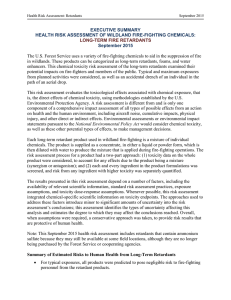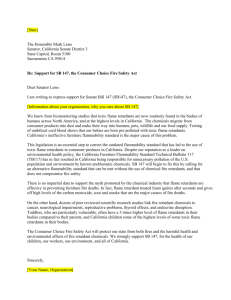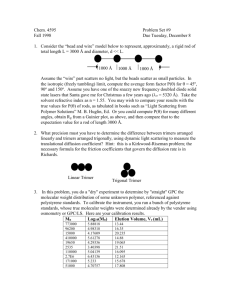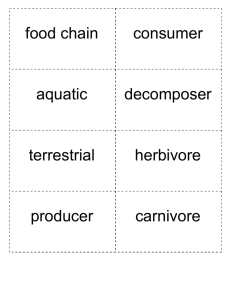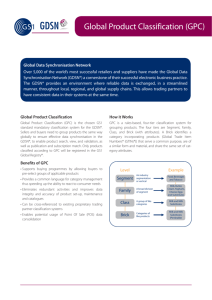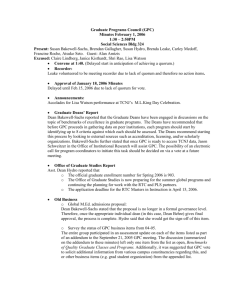The U.S. Forest Service uses a variety of fire-fighting chemicals... in wildlands. These products can be categorized as long-term retardants,... EXECUTIVE SUMMARY
advertisement
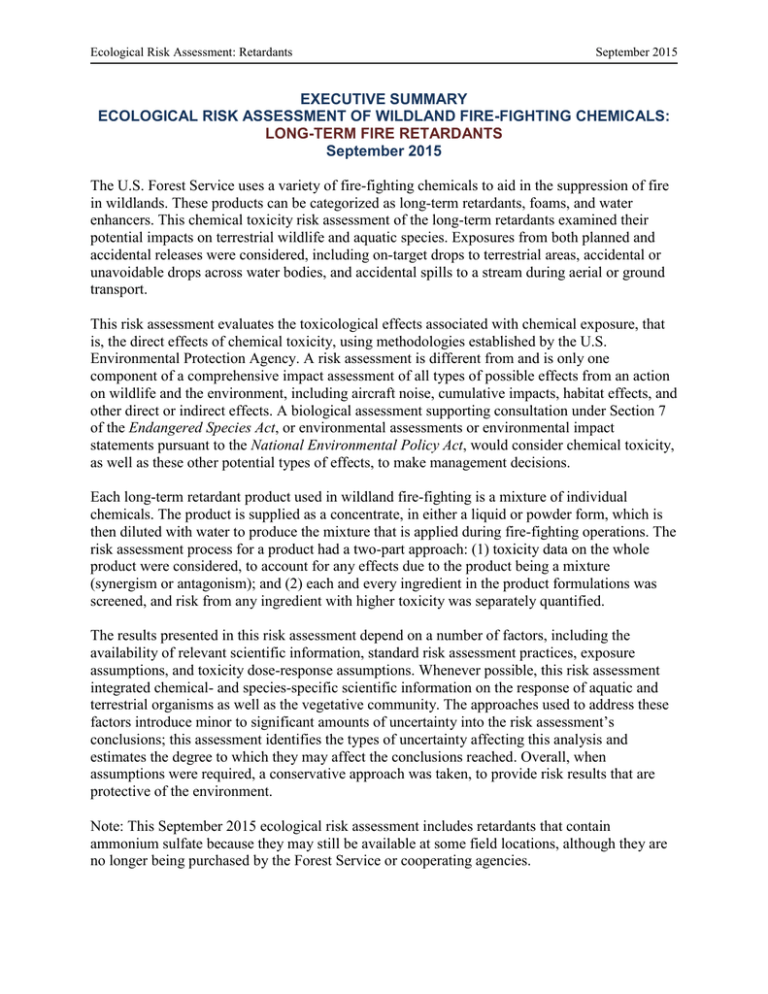
Ecological Risk Assessment: Retardants September 2015 EXECUTIVE SUMMARY ECOLOGICAL RISK ASSESSMENT OF WILDLAND FIRE-FIGHTING CHEMICALS: LONG-TERM FIRE RETARDANTS September 2015 The U.S. Forest Service uses a variety of fire-fighting chemicals to aid in the suppression of fire in wildlands. These products can be categorized as long-term retardants, foams, and water enhancers. This chemical toxicity risk assessment of the long-term retardants examined their potential impacts on terrestrial wildlife and aquatic species. Exposures from both planned and accidental releases were considered, including on-target drops to terrestrial areas, accidental or unavoidable drops across water bodies, and accidental spills to a stream during aerial or ground transport. This risk assessment evaluates the toxicological effects associated with chemical exposure, that is, the direct effects of chemical toxicity, using methodologies established by the U.S. Environmental Protection Agency. A risk assessment is different from and is only one component of a comprehensive impact assessment of all types of possible effects from an action on wildlife and the environment, including aircraft noise, cumulative impacts, habitat effects, and other direct or indirect effects. A biological assessment supporting consultation under Section 7 of the Endangered Species Act, or environmental assessments or environmental impact statements pursuant to the National Environmental Policy Act, would consider chemical toxicity, as well as these other potential types of effects, to make management decisions. Each long-term retardant product used in wildland fire-fighting is a mixture of individual chemicals. The product is supplied as a concentrate, in either a liquid or powder form, which is then diluted with water to produce the mixture that is applied during fire-fighting operations. The risk assessment process for a product had a two-part approach: (1) toxicity data on the whole product were considered, to account for any effects due to the product being a mixture (synergism or antagonism); and (2) each and every ingredient in the product formulations was screened, and risk from any ingredient with higher toxicity was separately quantified. The results presented in this risk assessment depend on a number of factors, including the availability of relevant scientific information, standard risk assessment practices, exposure assumptions, and toxicity dose-response assumptions. Whenever possible, this risk assessment integrated chemical- and species-specific scientific information on the response of aquatic and terrestrial organisms as well as the vegetative community. The approaches used to address these factors introduce minor to significant amounts of uncertainty into the risk assessment’s conclusions; this assessment identifies the types of uncertainty affecting this analysis and estimates the degree to which they may affect the conclusions reached. Overall, when assumptions were required, a conservative approach was taken, to provide risk results that are protective of the environment. Note: This September 2015 ecological risk assessment includes retardants that contain ammonium sulfate because they may still be available at some field locations, although they are no longer being purchased by the Forest Service or cooperating agencies. Ecological Risk Assessment: Retardants September 2015 Summary of Estimated Risks to Terrestrial Wildlife from Long-Term Retardants Fire retardants containing ammonium sulfate (Phos-Chek D75-R, D75-F, G75-F, and G75W) applied at rates of 4 gallons per 100 square feet (gpc) or higher were estimated to pose risks to non-sensitive small omnivores. Fire retardants containing ammonium sulfate were also predicted to present risks to sensitive small omnivores at 1 gpc or higher, sensitive raptors and songbirds at 2 gpc and higher, and sensitive herbivores and ground-nesting birds at 4 gpc and higher. Diammonium phosphate in Phos-Chek 259F was predicted to pose a risk to small omnivores when applied at a rate of 6 gpc. A performance ingredient in Phos-Chek 259F was predicted to pose a risk to sensitive small omnivores at 4 gpc and higher, and to sensitive songbirds at 6 gpc. The mixtures of individual ingredients in three products (Phos-Chek G75-W at 1 gpc and higher, 259F at 2 gpc and higher, and P100-F at 6 gpc) were predicted to present an additive risk to some animals, even though no risk to the animal at the same rate was expected from any one ingredient by itself. When evaluated based on the toxicity data for the formulated product as a whole, all powdered retardant products posed a risk to some sensitive terrestrial animals at certain rates of application. In most cases, these risks were consistent with or less than those predicted for the product based on evaluation of its ingredients, with two exceptions. In the case of Phos-Chek 259F, risks to sensitive raptors and songbirds were predicted for application rates as low as 3 gpc (compared to 6 gpc for the ingredient analysis). PhosChek MVP-F was predicted to pose a risk to sensitive omnivores at the highest rate evaluated of 6 gpc; this product was not associated with any ingredient-specific risks. In comparing these results to the limited field study data available, the assessment predicted risks from one retardant salt for which a previous field study had identified no adverse effects on terrestrial species. The inconsistency in these conclusions may be attributed to the conservative assumptions used in this risk assessment, particularly the assumption that the chemical was not attenuated by the environment prior to exposure of small mammals and the percent of diet assumed to be contaminated. Summary of Estimated Risks to Aquatic Wildlife from Long-Term Retardants No risks of acute toxic effects were predicted for aquatic wildlife in streams receiving runoff from land where retardant was applied to fuels (vegetation) at any coverage level (application rate) during fire-fighting activities. In the case of an accidental or unavoidable application of retardant across a small stream, risks to sensitive aquatic species were identified at one or more coverage levels (application rates) for four retardant salts, each present in multiple products: diammonium sulfate, diammonium phosphate, monoammonium phosphate, and ammonium polyphosphate. All retardant products present risk to one or more sensitive aquatic species if applied across a small stream. Ecological Risk Assessment: Retardants September 2015 The combinations of individual ingredients in three products (Phos-Chek D75-R at 3 or 4 gpc in a small stream, and Phos-Chek P100-F and MVP-F at 6 gpc in a small stream) were predicted to present an additive risk to sensitive fish, even though no risk in that scenario was expected from any one ingredient by itself. All concentrated and mixed retardants were associated with risk to one or more aquatic species if spilled into a small or large stream at the volumes assumed in risk assessment. For bivalves and aquatic stages of amphibians, risks of sublethal effects and risks from long-term exposures to ammonia were identified for some products (Phos-Chek D75-R, D75-F, 259F, G75-F, and G75-W), based on extremely conservative assumptions about the amount of un-ionized ammonia present. Runoff from retardant-treated areas is not expected to result in water concentrations that would pose a risk to freshwater mussels. However, as with other aquatic species, an accidental spill of concentrated or mixed retardant (particularly in a small stream) would likely result in mortality to mussels. Summary of Risk Evaluation for Plant Species Few studies have evaluated the potential effects of fire retardants on terrestrial vegetation. Overall, they indicate the possibility of phytotoxic effects to individual plants of more sensitive species at the application rates typically used, but generate no expectation of widespread or enduring impacts. The phytotoxic effects and vegetation diversity endpoints in this analysis have underlying links related to mechanisms of toxicity (for example, varying susceptibility to effects on seed germination among plant species). However, further exhaustive or quantitative analysis of the topic is not warranted, since only limited areas are treated with these products and the vegetation would otherwise be severely affected by the fire itself in the absence of their use.
